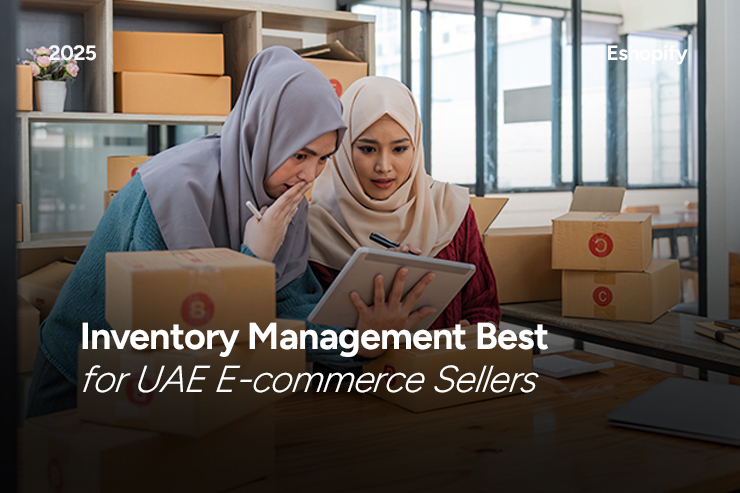 July 2, 2025 - By : man made marketing
July 2, 2025 - By : man made marketing
Efficient inventory management is the foundation of success for e-commerce sellers in the UAE, a market forecasted to grow at over 21% CAGR through 2033. Navigating multichannel selling, customs regulations, and fluctuating seasonal demand requires more than just guesswork—it requires strategy, accuracy, and smart systems.
That’s where Eshopify Fulfillment steps in. As a UAE-based 3PL (third-party logistics) provider, Eshopify empowers sellers with centralized warehousing, seamless API integrations, and expert regional logistics support—making fulfillment smarter and scaling simpler.
Inventory management starts with knowing what to expect. Inaccurate forecasting can lead to stockouts, overstocking, and lost revenue.
Analyze historical sales data and customer trends.
Adjust forecasts based on regional seasonality (e.g., Ramadan, White Friday, Dubai Shopping Festival).
Account for supply chain lead times, especially with international sourcing.
With real-time data integration, Eshopify empowers sellers to track sales and inventory across platforms, enabling more accurate, proactive forecasting.
Managing inventory across scattered locations can lead to delays and duplication. Centralizing inventory improves efficiency and visibility.
Single source of truth for stock levels across Amazon, Noon, Shopify, and DTC sites.
Reduced shipping time and cost due to strategic UAE-based storage.
Improved pick-pack speed and reduced order errors.
Eshopify’s Warehousing solutions include optimized layouts, barcode labeling, and climate control—ensuring faster fulfillment and greater inventory control.
Modern e-commerce operations require automation and integration to avoid delays and inaccuracies.
Use an inventory management system (IMS) that connects to your sales platforms.
Set up API integration for automatic syncing between your store, warehouse, and order systems.
API explained: A digital bridge that keeps your platforms connected in real time—so sales, stock, and orders are always in sync.
Eshopify offers robust API integrations that sync your data with zero manual entry, reducing errors and improving stock accuracy.
All integrations and inventory data are handled with industry-standard security protocols, ensuring your business and customer information remains protected.
Keeping the right amount of stock—not too much, not too little—is key to minimizing storage costs while avoiding lost sales.
Calculate your Reorder Point (ROP)—the stock threshold where new orders should be placed.
Use the Economic Order Quantity (EOQ) model to determine the most cost-efficient purchase quantity.
EOQ helps balance holding costs with ordering frequency to avoid excess inventory.
Regular cycle counts and audits are essential to validate stock accuracy. Eshopify’s warehouse operations include scheduled audits, ensuring your digital inventory reflects what’s physically available.
Returns are inevitable in e-commerce—but how you handle them affects your inventory integrity and customer satisfaction.
Track returned items with SKU-level visibility and restock or remove as needed.
Use insights from return data to reduce avoidable issues (e.g., incorrect sizing, packaging damage).
Establish a clear return flow with pre-labeled return slips or automated RMA (Return Merchandise Authorization) systems.
Eshopify’s Returns Management includes inspection, restocking, or disposal based on your preferences—helping you turn returns into revenue instead of loss.
When you’re ready to scale, doing everything in-house becomes a bottleneck. That’s where partnering with a 3PL like Eshopify makes all the difference.
Lower overhead and operational risk
Faster fulfillment and last-mile delivery within UAE and the GCC
Access to specialized services like Amazon FBA prep, bulk shipping, and customs clearance
Full-spectrum 3PL solutions tailored to the UAE and GCC e-commerce landscape
Amazon FBA-ready services including labeling, bundling, and compliance
Seamless expansion support for cross-border fulfillment
Proven performance:
30% faster order fulfillment
10–15% lower inventory holding costs
Stock accuracy improved from ~85% to over 95% after WMS integration
As the UAE’s e-commerce ecosystem continues to expand, the businesses that master inventory management will be the ones that thrive. From forecasting demand and centralizing storage, to leveraging real-time tracking, optimizing ROP and EOQ, and efficiently handling returns—every best practice adds resilience to your operations.
💡 Eshopify Fulfillment offers the infrastructure and technology to make inventory work for you—not against you.
Leave a comment